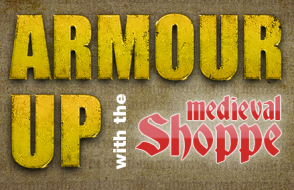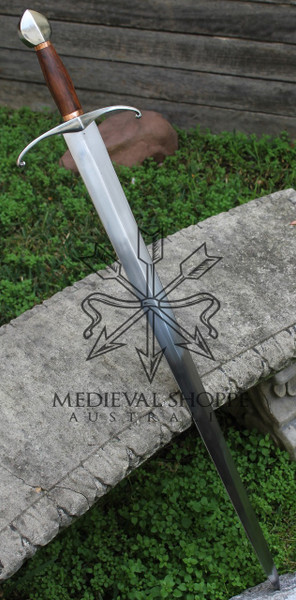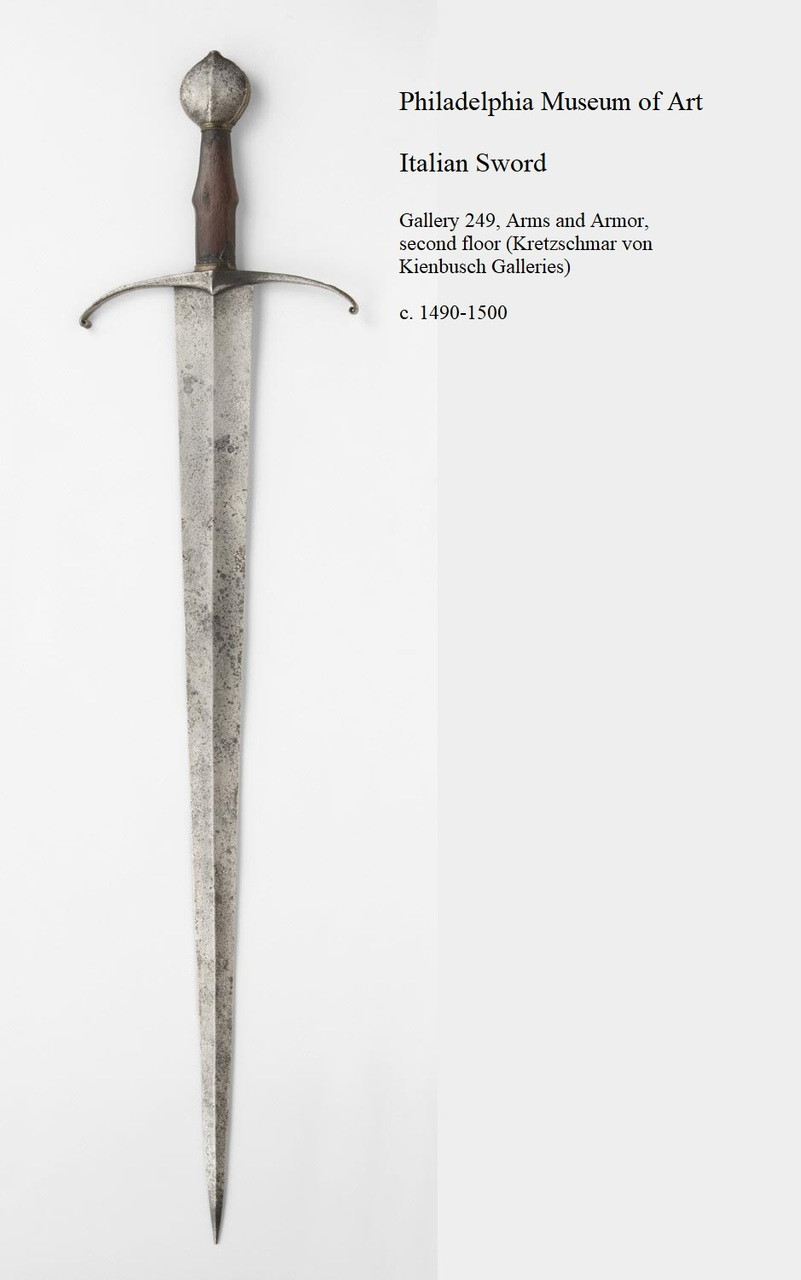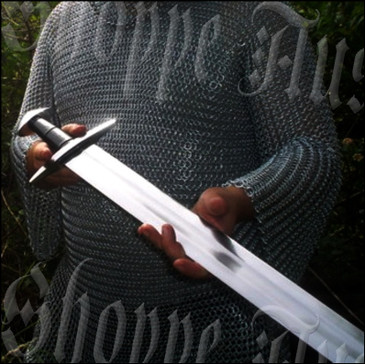-
Product Description
..
This weapon is based on a late medieval sword displayed at The Philadelphia Museum of Art ("Italian Sword, Cerca 1490-1500").
Common threads appear when one studies swords of the Migration Era, Viking Ages, and early Middle Ages. The majority of these swords are designed for cutting against the lightly armoured targets they faced. They are generally light and thin, with cross-sections that enable them to be flexible enough to handle the shock and torque of high velocity cuts. Prominently featured on these blades are one or more fullers, or grooves, that lighten the blade somewhat while allowing it to retain the flexibility and width required for devastating cuts. With the addition of plate armour in the high Middle Ages, these swords began to lose their effectiveness. Never operating in a vacuum, weapon makers of the day had to find a new way to counteract these defenses. Some chose to take the old fullered blades and improve them. Swords like this, however, represent a different approach .... a turning point at the close of the medieval era no less. This sword's diamond cross-section lends rigidity to the blade in thrusting, an action necessitated by increasing use of plate armour whilst its convex taper gives it more width at the Centre of Percussion yet it still tapers to an acute point suitable for finding gaps in armour.*
I thought the grip on the original (see picture) to be a little too thin and narrow for my large hands to grasp comfortably in the hammer grip. On similar grips my hand cramped up a little within a few swings, so the grip has been widened by 1cm. Also, to strengthen the blade the diamond cross-section on this copy is a little less pronounced, but all-in-all it's a clear copy of the original and would (I think) not look strange or foreign to any accomplished Italian bladesmith some 530 years ago. For several centuries Italian arms and armour were exported around Europe, so swords such as these would have been sold as far afield as Scotland and Germany, so to think of this as one that would have only appeared in Italy would be a mistake. In its day a good Italian sword was as much a status symbol as a good Italian suit or sports car is today.
With a Point of Balance relatively close to the cross, I expected this sword to lack some blade presence. What I found instead was a sword with nimble control and a pleasing amount of blade presence. I had no difficulty keeping the blade in line during cutting and experienced no vibrations unless my technique was off. This sword cuts well against light targets. When thrusting with the sword, it's easy to put the tip where you want it to go. This sword is a work of art - an absolute delight to look at: so with good reason it's displayed in an Art Museum - yet its functionality and beauty are not mutually exclusive.
Measurements and Specifications:
Weight: 1.35 Kg Overall length: 39 inches Blade length: 32 1/4 inches Blade width: 2 1/8 inches at base, tapering to 7/8 inches Grip length: 4 1/2 inches Guard width: 8 3/8 inches Point of Balance: 3 1/4 inches from guard Center of Percussion: ~18 inches from guard Oakeshott typology: Type XVIII blade, Type J1 pommel, Style 7 (?) guard *Something between Ewart Oakenshott's Type XV and Type XVIII. Both feature blades that are broad at the base, stiffer than their predecessors, Their main difference lies in how they taper to the point. Type XV swords typically feature a straight taper, giving the blade a triangular, or wedge, shape. Type XVIII blades feature a more convex taper. Sometimes the difference between the two types is very subtle, making classification difficult. Added to this is the fact that swords needed to be sharpened over their working life, and often needed more severe honing to remove nicks and gouges from their cutting edges. These actions remove metal from the blade and can sometimes have the effect of changing the blade's shape enough that it moves from one type to another.
-
Product Reviews
-
Italian sword
I just received my sword , It is beautiful, well made and come all oiled with a nice edge. Can't wait to get my next one from this shop. very happy. Unknown on 2nd Nov 2022
-
Beauty and beast
A hefty sword at the right price. The tapered blade coupled with the elegance of its hilt makes it a great choice for a strong sword. James Smeeth on 17th Aug 2022
-
Top notch sword!
This sword is not only beatiful but very functional. The weight and balance feels great, it has the mass for powerful cuts but also has the balance to make it a very nimble and fast blade. This sword has become one my absolute favorites, if you have an interest in late medieval swords i highly recommend checking out this beauty! Unknown on 24th Apr 2021
-
Heavy
About 300g too heavy and unwieldy to be an arming sword and hilt too short to be functional with two hands. Would be perfect if it was lighter or had a longer grip.
[Note from The Medieval Shoppe: It was based on the original sword, if it were redesigned, it would no longer be a copy of that sword.] Tony on 10th Oct 2020 -
fantastic craftsmanship
I haven't ordered from medieval shoppe in quite a while, previously the swords had been very good for their pricepoint although not without a few minor flaws. This most recent addition to my collection is however almost flawless and most certainly a bargain. The mirror polish on the guard and pommel are beautiful, the copper accenting looks amazing and the feel of the piece in the hand is near perfect Jeremy Shaw on 27th Dec 2018
-
-
Find Similar Products by Category
